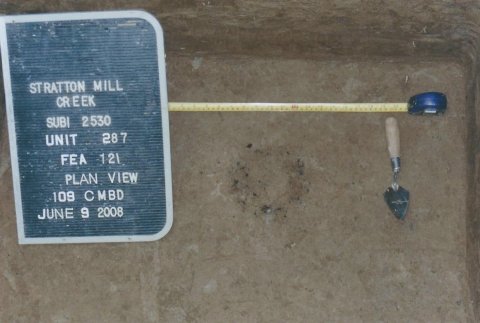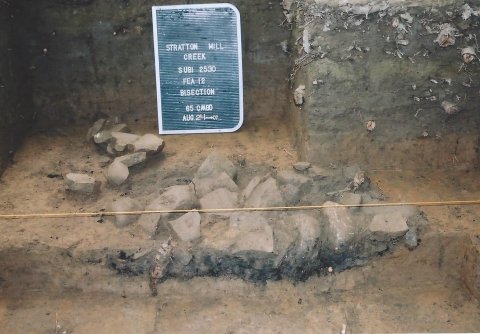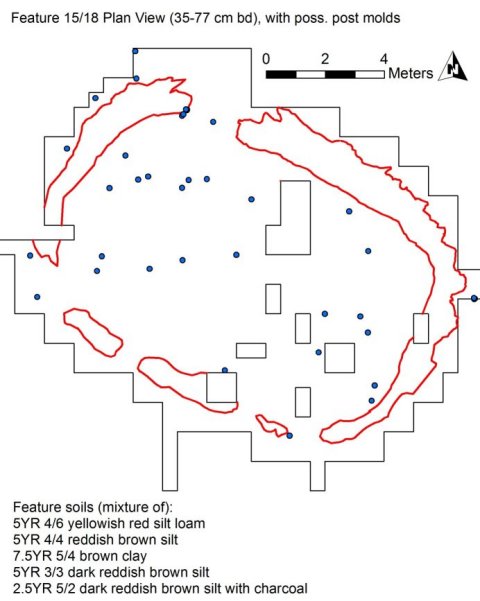A variety of feature types were present at the Stratton Mill Creek site, including cooking/heating features, a hide processing feature, a ring-shaped ditch, and post molds. Not all feature types were present during each period of site use. Archaeologists identified 14 features with the precontact occupations of the site.
Post molds are features representing the location of posts that were driven into the ground or placed into predug holes. They are the only evidence for above ground architecture in the Northeast. Archaeologists identified a total of 21 post molds and 26 possible post molds at Stratton Mill Creek. Only six were associated with a dated component, the Early Woodland component. The remaining 15 post molds and 26 possible post molds could not be assigned to a period of site use. Post molds on the terrace are associated with a large ring-shaped feature (discussed below), some of which hug the interior and exterior margins of the ditch. Interior posts may have supported a superstructure, such as a roof, or could represent platforms inside of a structure. No structural patterns were noted for the other site areas. These post molds may mark the areas of temporary shelters, windbreaks, or processing location, such as racks for drying fish.
Only one feature, a hearth, was associated with the Transitional component at the Stratton Mill Creek site. Hearth features are common on many precontact sites and represent open fires used for cooking, resource processing, heating, and light.

Archaeologists identified two Late Archaic features associated with the Ab4 horizon. One is a hearth and the other is a smudge pit, a feature used to smoke hides. The Late Archaic component associated with the Ab3 horizon contained a single hearth feature.
Associated with the Transitional component (Ab2 horizon) were a hearth and a fire-cracked rock (FCR) concentration. The FCR concentration may represent in situ fire-related activities or may be the result of cleaning another thermal feature.

A hearth and a roasting platform were associated with the Early Woodland (Ab1 horizon) period of site use. The roasting platform is characterized by a concentration of FCR and charcoal.

Five hearth features could not be associated with a period of site use.
The most unusual feature identified at the site is the large, ring-shaped ditch, which was found on the terrace. The more than 150 m2 feature is characterized by a ditch filled with charred chunks of tree, fire-reddened soil, and a diverse array of material culture. It was first identified at the base of the plow zone and was completely exposed and cross-sectioned at several locations. In addition to flakes, FCR, and rough stone tools (hammerstone; worked/flaked stone) recovered from the feature matrix, of note are three pieces of baked clay, possibly daub (clay used in structure construction), and a piece of hematite (a ferric oxide mineral used in pre-Contact rituals). No datable material culture was recovered from the feature. Radiometric and dendrochronology analyses on wood returned dates falling within the seventeenth century. An AMS date on nutshell from the feature produced a date falling within the early Middle Archaic. The ritual significance of the feature is suggested by the hematite as well as its unusual size. The interior of the feature measures approximately 14 m (46 ft) by 9 m (30 ft).
